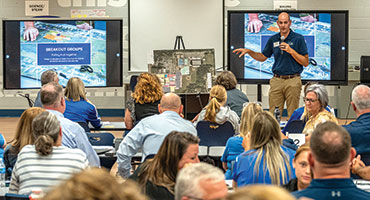At ThenDesign Architecture (TDA), collaboration is the cornerstone of each new project. Headquartered in Willoughby, Ohio, the award-winning firm has built a rich client and community engagement culture.
“If we have successfully designed a new school or facility, the members of the community should feel a sense of ownership and connection to the building, recognizing the significant role they played in its design,” says TDA President Chris Smith.
Whether collaborating on an elementary school media center or a college campus project, TDA’s team of architects, designers and planners engages with local stakeholders from the initial site assessment to well past the final walkthrough. Communication is an ongoing, integral part of the process.
Educational visioning sessions provide a platform to seek community feedback. Everyone in attendance, from students and parents to local officials and emergency service personnel, is encouraged to participate.
“When we are designing a new facility, we schedule forums to showcase visuals and conduct survey work to gather valuable input,” Smith says. “Through a consensus process, we are able to formulate the majority thought for the direction of the building and incorporate popular features into the design.”
While some communities want construction to reflect their cherished history, others look to be a bit more progressive. TDA team members utilize a variety of multimedia tools to enable stakeholders to conceptualize proposed designs. At interactive sessions, participants mark images with stickers to indicate their opinions on potential building features. TDA also incorporates videography and 3D animations.
“We can animate a walkthrough of a building before it goes to construction,” Smith says. “The animations take hundreds of hours to produce, but they help us assist school districts in communicating the results of the planning process.”
Design with learning in mind
While the community comes together to contribute to the building’s exterior and how it will interface with the neighborhood, TDA meets with district staff members to consider the building’s interior.
“A philosophy we hold is that professional educators need to have a voice in the design of their school,” Smith says. “Architecture should possess the flexibility to accommodate diverse teaching styles and enable students to learn in a variety of ways.”
Currently, Smith sees a trend toward more community-based, small-group learning.
“The middle school teaming model is starting to extend down into elementary grades and up into the lower grades of high school,” he says. “We are also seeing greater specialization and autonomy at the upper grades of high school, and space planning reflects that.”
Wide-reaching impact
Over 20 years ago, TDA formed the Cleveland Educational Design Alliance (CEDA) to bring together architects, engineers and designers specifically suited to address the unique building needs within the Cleveland Metropolitan School District’s multibillion-dollar program.
“Under the umbrella of CEDA, we pulled in experts to best serve the district,” Smith says. “It has been a wonderful relationship resulting in over 30 new buildings in the past two decades.”
Currently, TDA is the criteria architect for four additional Cleveland schools.
In 2023, the firm was hired to rewrite the Ohio School Design Manual (OSDM). Originally authored in 1998, the document guides all school construction across the state of Ohio and is the manual’s first significant rewrite. Included in the thousands of pages of guidelines will be LEED requirements of the U.S. Green Building Council, the increased demand for Wi-Fi connectivity and the transition from masonry to steel-based construction. In addition to bringing specifications up to date for Ohio’s educational facilities, TDA is assisting the Ohio Facilities Construction Commission (OFCC) in transitioning the publication to an online format.
“By opening new avenues to share standards for the design of public schools in Ohio, the goal is that educators can be more meaningfully involved in the process,” he says.
Historic school building becomes new headquarters
During the pandemic, TDA restored an unoccupied, century-old junior high school to create a new corporate headquarters.
“We were outgrowing our existing space and knew we wanted to stay in the city of Willoughby,” Smith says. “The opportunity presented itself, and it turned out to be a great project.”
The 24,000-square-foot space reflects its schoolhouse roots, complete with lockers, a learning center and studio space in the old gymnasium.
A ‘what-if’ culture
At TDA, a creative mindset is highly valued.
“We celebrate curiosity and ask folks to challenge the status quo,” Smith says. “Our people are our best asset, and we support their autonomy to freely engage their creativity in the design process.”
Some of the firm’s more than 50 employees have been with TDA for over 20 years. In 2024, the firm will inaugurate its first in-house pathway to leadership class.
“As a teaching-learning firm, we are committed to providing the resources and training people need to advance within the company,” he says. “We are always thinking about growth and longevity, but we recognize that you can never replace the human aspect of design.” ●

